A Simulation Study on the Impact of the Digital Economy on CO2 Emission Based on the System Dynamics Model
Abstract
:1. Introduction
2. Literature Review
2.1. Reviews of the Impact of the Digital Economy on CO2 Emission
2.2. Reviews of CO2 Emission Prediction Based on the SD Model
2.3. The Research Gap
3. Methodology
3.1. Subsystem Division
3.2. Model Setting
3.2.1. Causal Chains of the Digital Economy and CO2 Emission
3.2.2. Stock-Flow Diagram of the Digital Economy and CO2 Emission
3.3. Data Input
3.4. Model Testing
3.5. Scenario Designs
4. Simulation Results and Discussion
4.1. Results of Model Validation
4.2. Analysis of the Development Trend under the Baseline Scenario
4.2.1. Analysis of the Development Trend for the Digital Economy Subsystem
4.2.2. Analysis of the Development Trend for the Energy Consumption Subsystem
4.2.3. Analysis of the Development Trend for the CO2 Emission Subsystem
4.2.4. Comparison with the National Goal and Contemporary Works
4.3. Scenario Analysis of Different DEGR
4.3.1. Simulation Results under Different DEGR Scenarios
4.3.2. Comparison with Contemporary Works
4.4. Scenario Analysis of Different R&D Investment Intensity and Environment Investment Intensity
4.4.1. Simulation Results under Different R&D Investment Intensity and Environment Investment Intensity Scenarios
4.4.2. Comparison with Contemporary Works
5. Conclusions and Policy Implications
Author Contributions
Funding
Institutional Review Board Statement
Informed Consent Statement
Data Availability Statement
Conflicts of Interest
Appendix A
| Variable | Abbreviation of Variable | Unit | Value/Equation |
|---|---|---|---|
| Digital economy in 2005 | DE0 | 1012CNY | 2.6 |
| Digital economy growth per year | DEG | 1012CNY | DEG = DE*DEGR |
| Digital economy growth rate | DEGR | - | WITH LOOKUP (time, [(2005,0)-(2040,1)], (2005,0.282), (2006,0.22),(2007,0.1803),(2008,0.3264),(2009,0.2461),(2010,0.1975),(2011,0.2351),(2012,0.1903),(2013,0.1599),(2014,0.158),(2015,0.2047),(2016,0.20354),(2017,0.1507),(2018,0.1438),(2019,0.09),(2021,0.09),(2040,0.09)) |
| Digital economy | DE | 1012CNY | DE = INTEG (DEG, DEG0) |
| Ratio of digital economy to GDP | RDGDP | - | WITH LOOKUP (time, [(2005,0)-(2040,1)], (2005,0.1389), (2006,0.1519),(2007,0.1506),(2008,0.1504),(2009,0.1827),(2010,0.1925),(2011,0.1947),(2012,0.2179),(2013,0.2355),(2014,0.2517),(2015,0.2723),(2016,0.3028),(2017,0.3269),(2018,0.3405),(2019,0.3629),(2020,0.3868),(2030,0.5518), (2040,0.7202)) |
| Ratio of digital industrialization to digital economy | RDI | - | RDI = 1 − RID |
| Ratio of industry digitization to digital economy | RID | - | WITH LOOKUP (time, [(2005,0)-(2040,1)], (2005,0.49), (2008,0.58),(2011,0.68),(2015,0.743),(2016,0.77),(2017,0.774),(2018,0.795),(2019,0.802),(2020,0.809),(2030,0.838),(2040,0.854)) |
| Digital industrialization | DI | 1012CNY | DI = DE*RDI |
| Industry digitization | ID | 1012CNY | ID = DE*RID |
| Gross domestic product | GDP | 1012CNY | GDP = (ID + DI)/RDGDP |
| Share of primary industry | SPI | % | IS1 = 100 − SSI − STI |
| Share of secondary industry | SSI | % | WITH LOOKUP (time, [(2005,0)-(2040,100)], (2005,47), (2006,47.6),(2009,46),(2011,46.5),(2016,39.6),(2020,37.8),(2030,34),(2040,29)) |
| Share of tertiary industry | STI | % | WITH LOOKUP (time, [(2005,0)-(2040,100)], (2005,41.3), (2006,41.8),(2009,44.4),(2011,44.3),(2016,52.4),(2020,54.5),(2030,59.2),(2040,65.2)) |
| Primary industrial GDP | GDPP | 1012CNY | GDPP = GDP*SPI |
| Secondary industrial GDP | GDPS | 1012CNY | GDPS = GDP*SSI |
| Tertiary industrial GDP | GDPT | 1012CNY | GDPT = GDP*STI |
| Total factor productivity | TFP | - | TFP = SQRT(−0.809 + 118.693*RRD + 0.009*DE) R2 = 0.936 |
| Ratio of R&D investment to GDP | RRD | - | WITH LOOKUP (time, [(2005,0)-(2040,1)], (2005,0.0131), (2006,0.0137),(2007,0.0137),(2008,0.0145),(2009,0.0166),(2010,0.0171),(2011,0.0178),(2012,0.0191),(2013,0.02),(2014,0.0202),(2015,0.0206),(2016,0.021),(2017,0.0212),(2018,0.0214),(2019,0.0224),(2020,0.0241),(2030,0.0291),(2040,0.0341)) |
| Energy technology innovation (hydropower and wind power generation capacity) | ETI | 108kilowatts | ETI = EXP(−0.805 + 0.457*ln(DE) + 43.433*RRD) R2 = 0.994 |
| Energy consumption intensity | ECI | 10−4tce/CNY | ECI = TEC/GDP |
| Energy consumption intensity of primary industry | ECIP | 10−4tce/CNY | ECIP = EXP(−1.434 − 0.784*ln(TFP) − 0.18*ln(ETI)) R2 = 0.967 |
| Energy consumption intensity of secondary industry | ECIS | 10−4tce/CNY | ECIS = EXP(0.607 − 0.496*ln(TFP) − 0.288*ln(ETI)) R2 = 0.973 |
| Energy consumption intensity of tertiary industry | ECIT | 10−4tce/CNY | ECIT = EXP(−0.869 − 0.297*ln(TFP) − 0.447*ln(ETI)) R2 = 0.978 |
| Energy consumption of primary industry | ECP | 108tce | ECP = GDPP*ECIP |
| Energy consumption of secondary industry | ECS | 108tce | ECS = GDPS*ECIS |
| Energy consumption of tertiary industry | ECT | 108tce | ECT = GDPT*ECIT |
| Industrial energy consumption | IEC | 108tce | IEC = ECP + ECS + ECT |
| Total population in 2005 | POP0 | 108 person | 13.1 |
| Population growth per year | POPG | 108 person | POPG = (1/1000)*TPOP*NPGR |
| Total population | TPOP | 108 person | TPOP = INTEG (POPG, POP0) |
| Natural population growth rate | NPGR | ‰ | WITH LOOKUP (time, [(2005,0)-(2040,10)], (2005,5.2923), (2006,5.1808), (2007,5.0935), (2008,4.8794), (2009,4.8033), (2010,6.1525),(2011,7.4565),(2012,5.9152),(2013,6.7288),(2014,4.9402),(2015,6.5497),(2016,5.595),(2017,3.7854),(2018,3.3229),(2019,1.4467),(2030,2.68),(2040,1.37)) |
| GDP per capita | PGDP | 104CNY/person | PGDP = GDP/TPOP |
| Digital economy per capita | PDE | 104CNY/person | PDE = DE/TPOP |
| Residents’ energy consumption | REC | 108tce | REC = 1.408 − 0.018*DE + 0.789*PGDP R2 = 0.991 |
| Other energy consumption from statistical bias | OEC | 108tce | WITH LOOKUP (time, [(2005,0)-(2040,10)], (2005,2.5372), (2006,2.7791),(2007,3.0934),(2008,2.9163),(2009,0),(2040,0)) |
| Government environmental governance efficiency | GEGE | 109CNY/ton | GEGE = EXP(−6.042 + 0.017*DE + 0.755*RIEPC) R2 = 0.984 |
| Ratio of investment in environmental pollution control to GDP | RIEPC | % | WITH LOOKUP (time, [(2005,0)-(2040,100)], (2005,1.27), (2006,1.36),(2007,1.55),(2008,1.51),(2009,1.62),(2010,1.46),(2011,1.56),(2012,1.52),(2013,1.49),(2014,1.28),(2015,1.24),(2016,1.15),(2017,1.5),(2018,1.4),(2019,0.9),(2020,1),(2022,1.357),(2040,1.357)) |
| Total energy consumption | TEC | 108tce | TEC = IEC + REC + OEC |
| Share of coal consumption | SCC | - | SCC = EXP(−0.261 − 0.039*ETI − 0.239*GEGE) R2 = 0.974 |
| Share of oil consumption | SOC | - | SOC = IF THEN ELSE(1-SCC-SNGC-SNFC > 0, 1-ESC-ESG-ESNF, 0) |
| Share of natural gas consumption | SNGC | - | SNGC = 0.069 + 0.01*ln(GEGE) + 0.014*ln(ETI) R2 = 0.986 |
| Share of non-fossil energy consumption | SNFC | - | SNFC = 0.054 +0.063 *GEGE+ 0.014*ETI R2 = 0.974 |
| Coal consumption | CC | 108tce | CC = TEC*SCC |
| Oil consumption | OC | 108tce | OC = TEC*SOC |
| Natural gas consumption | NGC | 108tce | NGC = TEC*SNGC |
| Non-fossil energy consumption | NFC | 108tce | NFC = TEC*SNFC |
| CO2 emission of coal | CEC | 108ton | CEC = CC*CCEC |
| CO2 emission of oil | CEO | 108ton | CEO = OC*CCEO |
| CO2 emission of natural gas | CENG | 108ton | CENG = NGC*CCENG |
| Coefficient of CO2 emission of coal | CCEC | ton/tce | 2.64 |
| Coefficient of CO2 emission of oil | CCEO | ton/tce | 2.08 |
| Coefficient of CO2 emission of natural gas | CCENG | ton/tce | 1.63 |
| CO2 emission | CO2 | 108 ton | CO2 = CEC + CEO + CENG |
| CO2 emission intensity | CEI | 10−4ton /CNY | CEI = CO2/GDP |
| CO2 emission per capita | CEP | ton /person | CEP = CO2/TPOP |
References
- Said, Z.; Sharma, P.; Elavarasan, R.M.; Tiwari, A.K.; Rathod, K. Exploring the specific heat capacity of water-based hybrid nanofluids for solar energy applications: A comparative evaluation of modern ensemble machine learning techniques. J. Energy Storage 2022, 54, 105230. [Google Scholar] [CrossRef]
- Yang, H.; Li, X.; Ma, L.; Li, Z. Using system dynamics to analyse key factors influencing China’s energy-related CO2 emission and emission reduction scenarios. J. Clean. Prod. 2021, 320, 128811. [Google Scholar] [CrossRef]
- Gu, S.; Fu, B.; Thriveni, T.; Fujita, T.; Ji, W.A. Coupled LMDI and system dynamics model for estimating urban CO2 emission mitigation potential in Shanghai, China. J. Clean. Prod. 2019, 240, 118034. [Google Scholar] [CrossRef]
- Zhang, W.; Liu, X.; Wang, D.; Zhou, J. Digital economy and carbon emission performance: Evidence at China’s city level. Energy Policy 2022, 165, 112927. [Google Scholar] [CrossRef]
- Jinping Xi Delivers a Keynote Speech at the 75th UN General Assembly General Debate. Available online: http://www.cppcc.gov.cn/zxww/2020/09/23/ARTI1600819264410115.shtml?from=groupmessage (accessed on 20 August 2022).
- British Petroleum. Statistical Review of World Energy 2021. Available online: https://www.bp.com/content/dam/bp/business-sites/en/global/corporate/pdfs/energy-economics/statistical-review/bp-stats-review-20 (accessed on 20 August 2022).
- Xu, B.; Lin, B. Can expanding natural gas consumption reduce China’s CO2 emission? Energy Econ. 2019, 81, 393–407. [Google Scholar] [CrossRef]
- Li, Y.; Yang, X.; Ran, Q.; Wu, H.; Irfan, M. Energy structure, digital economy, and carbon emissions: Evidence from China. Environ. Sci. Pollut. Res. 2021, 28, 64606–64629. [Google Scholar] [CrossRef]
- Heiskanen, E.; Jalas, M.; Timonen, P. Reducing the natural resource intensity of private and organizational consumption: The potential of ICT and service innovations. Prog. Ind. Ecol. Int. J. 2005, 2, 453–474. [Google Scholar] [CrossRef]
- Zhou, X.; Zhou, D.; Zhao, Z.; Wang, Q. A framework to analyze carbon impacts of digital economy: The case of China. Sustain. Prod. Consum. 2022, 31, 357–369. [Google Scholar] [CrossRef]
- Salahuddin, M.; Alam, K. Information and Communication Technology, electricity consumption and economic growth in OECD countries: A panel data analysis. Int. J. Electr. Power 2016, 76, 185–193. [Google Scholar] [CrossRef]
- Open Data Center Council. Data Center Computing Carbon Efficiency White Paper. Available online: http://www.odcc.org.cn/download/24 (accessed on 30 January 2023).
- Ghobakhloo, M. Industry 4.0, digitization, and opportunities for sustainability. J. Clean. Prod. 2020, 252, 119869. [Google Scholar] [CrossRef]
- Noussan, M.; Tagliapietra, S. The effect of digitalization in the energy consumption of passenger transport: An analysis of future scenarios for Europe. J. Clean. Prod. 2020, 258, 120926. [Google Scholar] [CrossRef]
- Lin, B.; Zhou, Y. Does the Internet development affect energy and carbon emission performance? Sustain. Prod. Consum. 2021, 28, 1–10. [Google Scholar] [CrossRef]
- Sadorsky, P. Information communication technology and electricity consumption in emerging economies. Energy Policy 2012, 48, 130–136. [Google Scholar] [CrossRef]
- Shvakov, E.E.; Petrova, E.A. Newest Trends and Future Scenarios for a Sustainable Digital Economy Development; Institute of Scientific Communications Conference; Springer: Cham, Germany, 2019; pp. 1378–1385. [Google Scholar] [CrossRef]
- Salahuddin, M.; Alam, K.; Ozturk, I. The effects of Internet usage and economic growth on CO2 emission in OECD countries: A panel investigation. Renew. Sustain. Energy Rev. 2016, 62, 1226–1235. [Google Scholar] [CrossRef]
- Li, X.; Liu, J.; Ni, P. The Impact of the digital economy on CO2 emission: A theoretical and empirical analysis. Sustainability 2021, 13, 7267. [Google Scholar] [CrossRef]
- Li, Z.; Wang, J. The Dynamic Impact of Digital Economy on Carbon Emission Reduction: Evidence City-level Empirical Data in China. J. Clean. Prod. 2022, 351, 131570. [Google Scholar] [CrossRef]
- Li, D.; Huang, G.; Zhu, S.; Chen, L.; Wang, J. How to peak carbon emissions of provincial construction industry? Scenario analysis of Jiangsu Province. Renew. Sustain. Energy Rev. 2021, 144, 110953. [Google Scholar] [CrossRef]
- Ansari, N.; Seifi, A. A system dynamics model for analyzing energy consumption and CO2 emission in Iranian cement industry under various production and export scenarios. Energy Policy 2013, 58, 75–89. [Google Scholar] [CrossRef]
- Liu, J.; Zhang, X.; Song, X. Regional carbon emission evolution mechanism and its prediction approach driven by carbon trading—A case study of Beijing. J. Clean. Prod. 2018, 172, 2793–2810. [Google Scholar] [CrossRef]
- China Academy of Information and Communications Technology (CAICT). China Digital Economy Development Report (2022). Available online: http://www.caict.ac.cn/kxyj/qwfb/bps/202207/P020220729609949023295.pdf (accessed on 20 August 2022).
- China Energy Statistical Yearbook. Available online: https://data.cnki.net/home (accessed on 20 August 2022).
- Ivus, O.; Boland, M. The employment and wage impact of broadband deployment in Canada. Can. J. Econ. 2015, 48, 1803–1830. [Google Scholar] [CrossRef]
- Jiménez, M.; Matus, J.A.; Martínez, M.A. Economic growth as a function of human capital, internet and work. Appl. Econ. 2014, 46, 3202–3210. [Google Scholar] [CrossRef]
- Lange, S.; Pohl, J.; Santarius, T. Digitalization and energy consumption. Does ICT reduce energy demand? Ecol. Econ. 2020, 176, 106760. [Google Scholar] [CrossRef]
- Zhou, X.; Zhou, D.; Wang, Q.; Su, B. How information and communication technology drives carbon emissions: A sector-level analysis for China. Energy Econ. 2019, 81, 380–392. [Google Scholar] [CrossRef]
- European Commission. A European Strategy for data.2020. Available online: https://ec.europa.eu/futurium/en/european-ai-alliance/european-strategy-data.html (accessed on 20 August 2022).
- The Cambridge Centre for Alternative Finance (CCAF). Cambridge University’s Bitcoin Electricity Consumption Index. Available online: https://www.ft.com/content/1aecb2db-8f61-427c-a413-3b929291c8ac (accessed on 20 August 2022).
- Open Data Center Committee. Data Center Server Carbon Accounting Guidelines. 2021. Available online: http://www.odcc.org.cn/download/p-1485866070699302913.html (accessed on 20 August 2022).
- Cui, P.; Xia, S.; Hao, L. Do different sizes of urban population matter differently to CO2 emission in different regions? Evidence from electricity consumption behavior of urban residents in China. J. Clean. Prod. 2019, 240, 118207. [Google Scholar] [CrossRef]
- Pop, R.A.; Dabija, D.C.; Pelău, C.; Dinu, V. Usage Intentions, Attitudes, and Behaviors towards Energy-Efficient Applications during the COVID-19 Pandemic. J. Bus. Econ. Manag. 2022, 23, 668–689. [Google Scholar] [CrossRef]
- Wang, Z.; Zhao, X.G.; Zhou, Y. Biased technological progress and total factor productivity growth: From the perspective of China’s renewable energy industry. Renew. Sustain. Energy Rev. 2021, 146, 111136. [Google Scholar] [CrossRef]
- Global e-Sustainability Initiative. GeSI SMARTer 2030: ICT Solutions for 21st Century Challenges. Available online: http://smarter2030.gesi.org/downloads (accessed on 20 August 2022).
- Liu, Y.; Yang, Y.; Li, H.; Zhong, K. Digital economy development, industrial structure upgrading and green total factor productivity: Empirical evidence from China’s cities. Int. J. Environ. Res. Public Health 2022, 19, 2414. [Google Scholar] [CrossRef]
- Graetz, G.; Michaels, G. Robots at work. Rev. Econ. Stat. 2018, 100, 753–768. [Google Scholar] [CrossRef]
- Andronie, M.; Lăzăroiu, G.; Ștefănescu, R.; Uță, C.; Dijmărescu, I. Sustainable, smart, and sensing technologies for cyber-physical manufacturing systems: A systematic literature review. Sustainability 2021, 13, 5495. [Google Scholar] [CrossRef]
- Andronie, M.; Lăzăroiu, G.; Iatagan, M.; Uță, C.; Ștefănescu, R.; Cocoșatu, M. Artificial Intelligence-Based Decision-Making Algorithms, Internet of Things Sensing Networks, and Deep Learning-Assisted Smart Process Management in Cyber-Physical Production Systems. Electronics 2021, 10, 2497. [Google Scholar] [CrossRef]
- Sharma, P.; Bora, B.J. A Review of Modern Machine Learning Techniques in the Prediction of Remaining Useful Life of Lithium-Ion Batteries. Batteries 2022, 9, 13. [Google Scholar] [CrossRef]
- He, R.; Zhong, M.; Huang, J. Technological progress and metal resource consumption in the electricity industry—A cross-country panel threshold data analysis. Energy 2021, 231, 120979. [Google Scholar] [CrossRef]
- Allam, Z.; Jones, D.S. Future (post-COVID) digital, smart and sustainable cities in the wake of 6G: Digital twins, immersive realities and new urban economies. Land Use Policy 2021, 101, 105201. [Google Scholar] [CrossRef]
- The International Renewable Energy Agency (IRENA). Renewable Energy Generation Costs 2020. Available online: https://www.irena.org/publications/2021/Jun/Renewable-Power-Costs-in-2020 (accessed on 20 August 2022).
- Bhattacharya, M.; Rafiq, S.; Bhattacharya, S. The role of technology on the dynamics of coal consumption–economic growth: New evidence from China. Appl. Energy 2015, 154, 686–695. [Google Scholar] [CrossRef]
- Shahbaz, M.; Wang, J.; Dong, K.; Zhao, J. The impact of digital economy on energy transition across the globe: The mediating role of government governance. Renew. Sustain. Energy Rev. 2022, 166, 112620. [Google Scholar] [CrossRef]
- China Academy of Information and Communications Technology (CAICT). White Paper on the Development of China’s Digital Economy. 2022. Available online: http://www.caict.ac.cn/kxyj/qwfb/bps/202201/t20220126_396162.htm (accessed on 20 August 2022).
- Yang, Y.; Cai, W.; Wang, C. Industrial CO2 intensity, indigenous innovation and R&D spillovers in China’s provinces. Appl. Energy 2014, 131, 117–127. [Google Scholar] [CrossRef]
- Shen, Y.; Yue, S.; Sun, S.; Guo, M. Sustainable total factor productivity growth: The case of China. J. Clean. Prod. 2020, 256, 120727. [Google Scholar] [CrossRef]
- The National Bureau of Statistics. Available online: https://data.stats.gov.cn/index.htm (accessed on 20 July 2022).
- China Statistical Yearbook. Available online: https://data.stats.gov.cn/publish.htm?sort=1 (accessed on 20 July 2022).
- Ma, Q.; Tariq, M.; Mahmood, H.; Khan, Z. The nexus between digital economy and CO2 emission in China: The moderating role of investments in research and development. Technol. Soc. 2022, 68, 101910. [Google Scholar] [CrossRef]
- The Outline of the National Medium- and Long-Term Science and Technology Development Plan (2006–2020). Available online: http://www.gov.cn/gongbao/content/2006/content_240244.htm (accessed on 20 July 2022).
- Ministry of Housing and Urban-Rural Development of the People’s Republic of China. National Urban Ecological Protection and Construction Plan (2015–2020). Available online: https://www.mohurd.gov.cn/gongkai/fdzdgknr/tzgg/201612/20161223_230049.html (accessed on 20 July 2022).
- National Development and Reform Commission. 14th Five-Year Plan for Digital Economy Development. Available online: https://www.ndrc.gov.cn/fggz/fzzlgh/gjjzxgh/202203/t20220325_1320207.html (accessed on 20 July 2022).
- Notice of Action Plan of State Council on the issuance of the carbon peak by 2030. Available online: http://www.gov.cn/zhengce/zhengceku/2021-10/26/content_5644984.htm (accessed on 20 July 2022).
- Liu, D.; Xiao, B. Can China achieve its carbon emission peaking? A scenario analysis based on STIRPAT and system dynamics model. Ecol. Indic. 2018, 93, 647–657. [Google Scholar] [CrossRef]
- Zhang, F.; Deng, X.Z.; Xie, L.; Xu, N. China’s energy-related carbon emissions projections for the shared socioeconomic pathways. Resour. Conserv. Recycl. 2021, 168, 105456. [Google Scholar] [CrossRef]
- Tian, Y.; Li, L. Will COVID-19 affect China’s peak CO2 emissions in 2030? An analysis based on the systems dynamics model of green finance. J. Clean. Prod. 2022, 356, 131777. [Google Scholar] [CrossRef]

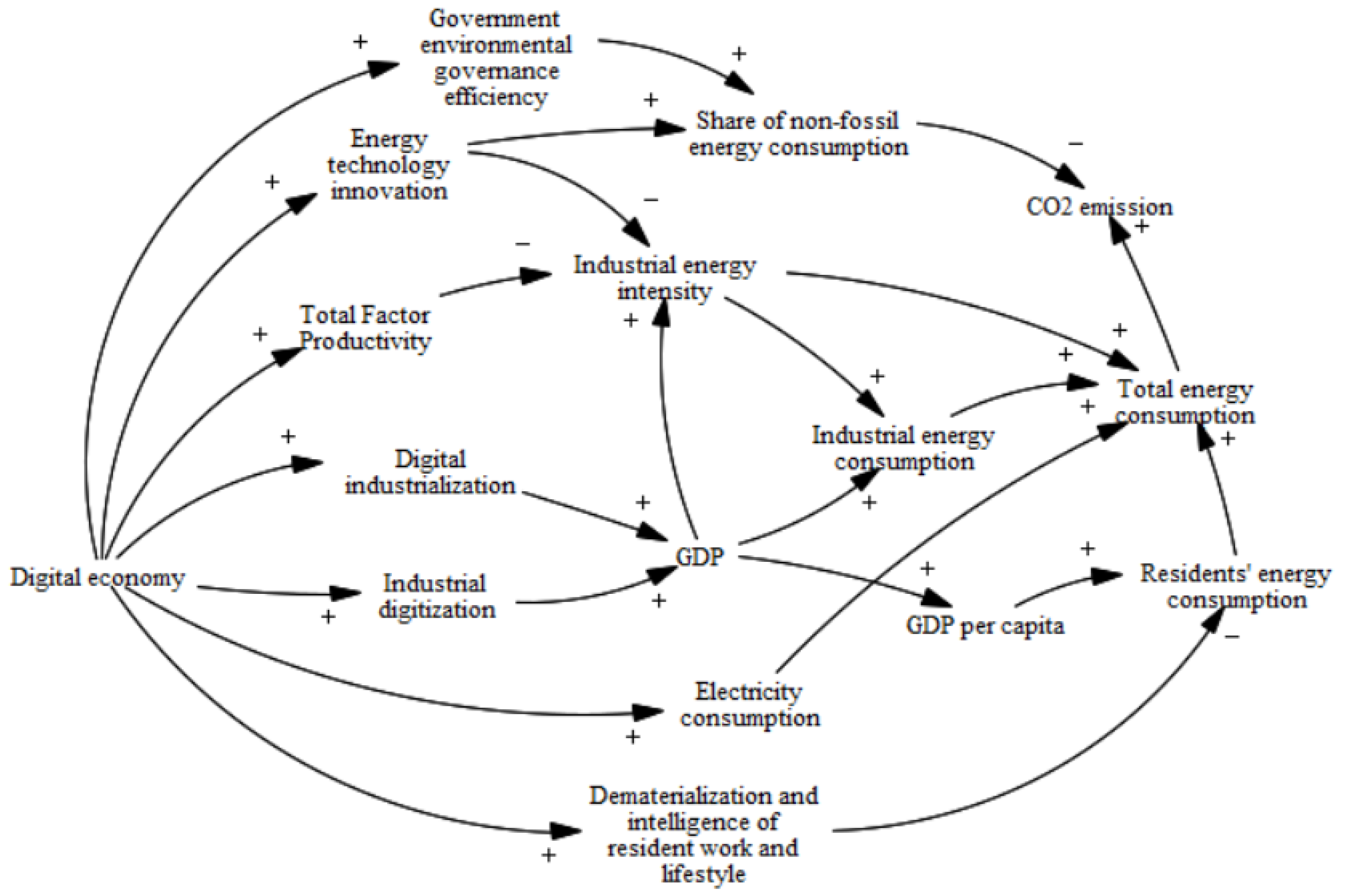

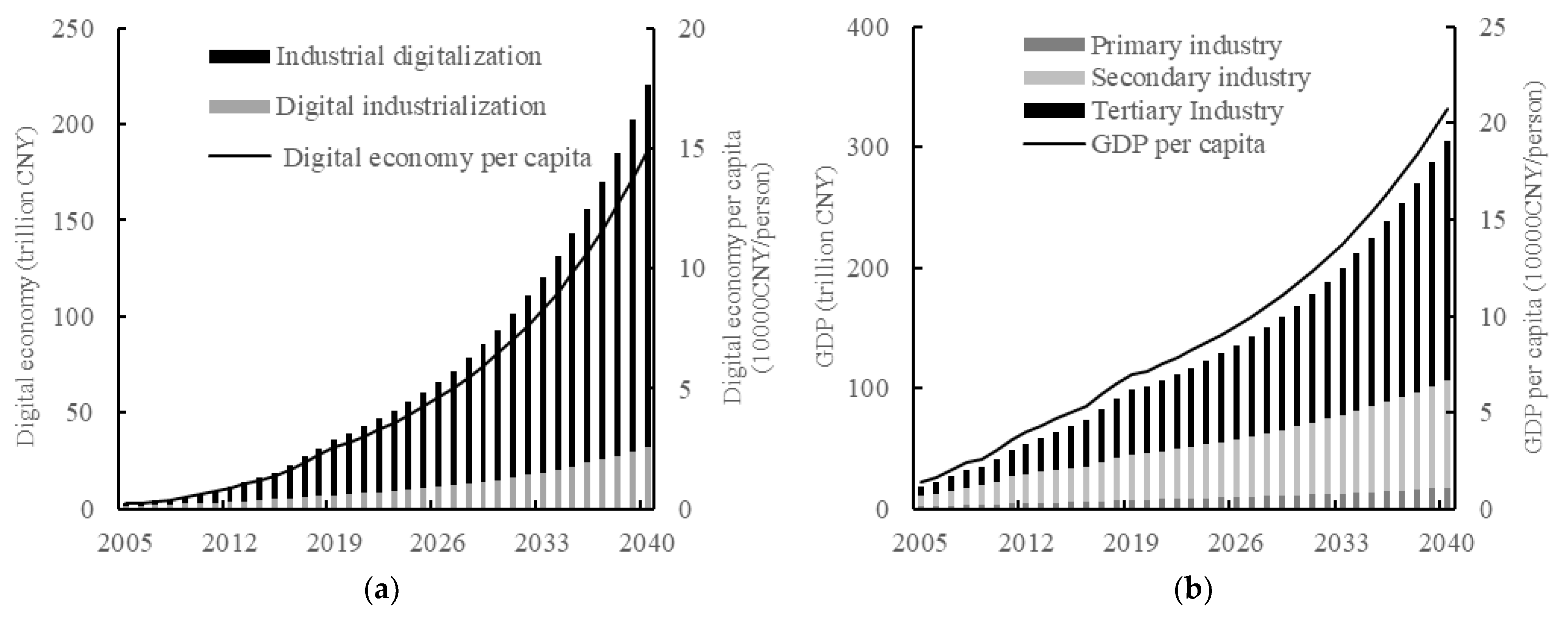
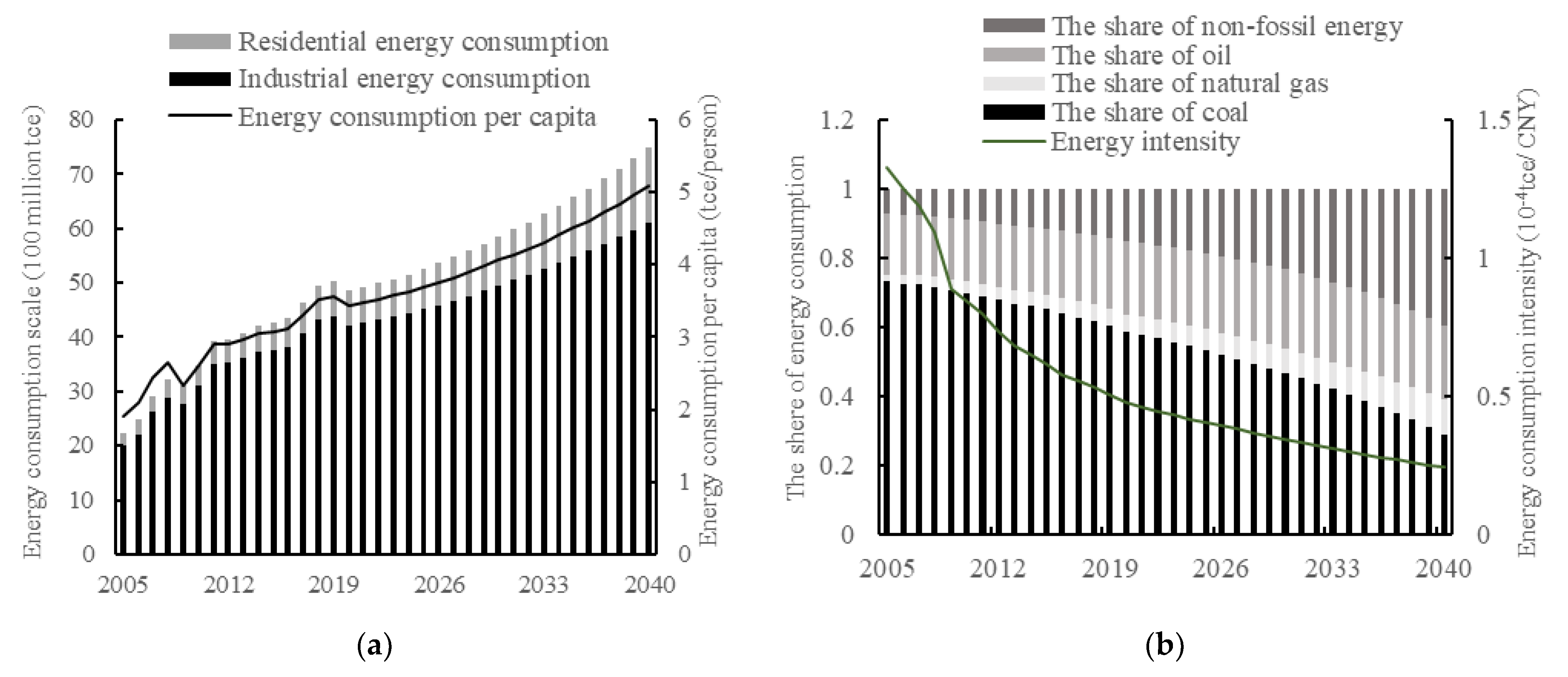
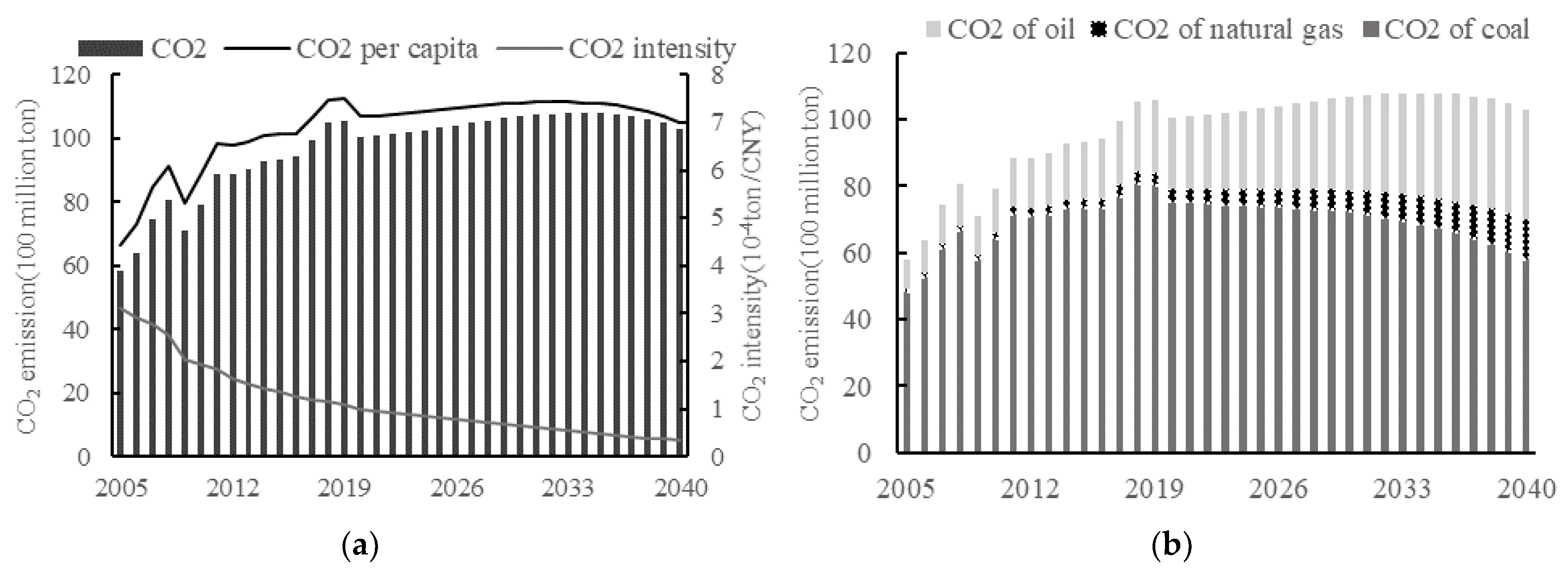

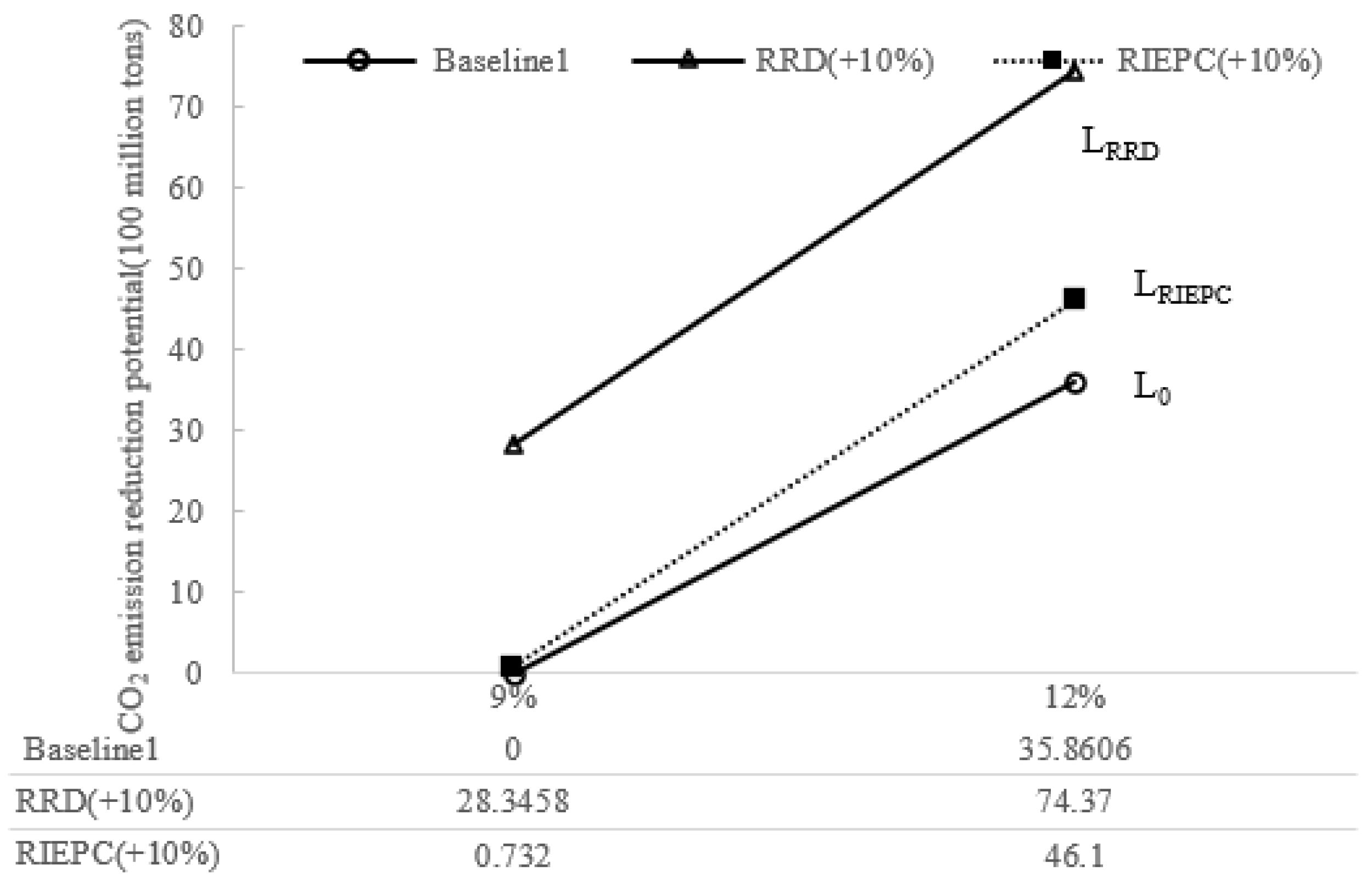
| Types of Research | Reference | Method | Whether to Consider the Impact of the Digital Economy on CO2 Emission | Whether to Study the Interaction and Dynamic Feedback of Factors | Whether Key Variables Are Predicted | Whether to Study the Influencing Factors of CERDE |
|---|---|---|---|---|---|---|
| First type of research | Zhang et al. (2022) [4] | Ordinary least square (OLS) method, threshold model, mediation effect model, and spatial Durbin model | Yes | No | No | No |
| Li et al. (2021) [19] | Fixed-effects model | Yes | No | No | No | |
| Lin and Zhou (2021) [15] | Fixed-effect model and mediation effect model | Yes | No | No | No | |
| Li and Wang (2022) [20] | Spatial Durbin model and panel threshold model | Yes | No | No | No | |
| Li et al. (2021) [8] | System GMM model, moderation effect model, and threshold effect model | Yes | No | No | No | |
| Ghobakhloo et al. (2020) [13] | Qualitative analysis method | Yes | No | No | No | |
| Second type of research | Yang et al. (2021) [2] | SD method | No | Yes | Yes | No |
| Liu et al. (2018) [23] | STIRPAT and SD model | No | Yes | Yes | No | |
| Gu et al. (2019) [3] | Coupled LMDI and SD model | No | Yes | Yes | No | |
| Li et al. (2021) [21] | SD model | No | Yes | Yes | No |
| DE (Trillion Chinese Yuan (CNY)) | TEC (100 Million Tce) | CO2 Emission (100 Million Tons) | |||||||
|---|---|---|---|---|---|---|---|---|---|
| Time | Ft | Ht | et (%) | Ft | Ht | et (%) | Ft | Ht | et (%) |
| 2005 | 2.60 | 2.60 | 0.00 | 24.93 | 26.14 | 4.62 | 58.14 | 60.66 | 4.15 |
| 2010 | 7.93 | 7.93 | 0.00 | 34.81 | 36.06 | 3.47 | 79.13 | 81.29 | 2.66 |
| 2015 | 18.76 | 18.76 | 0.00 | 42.57 | 43.41 | 1.94 | 93.32 | 93.84 | 0.55 |
| 2016 | 22.60 | 22.60 | 0.01 | 43.40 | 44.15 | 1.70 | 94.27 | 94.06 | 0.22 |
| 2017 | 27.20 | 27.20 | 0.01 | 46.30 | 45.58 | 1.58 | 99.54 | 95.97 | 3.72 |
| 2018 | 31.30 | 31.30 | 0.01 | 49.31 | 47.19 | 4.49 | 105.18 | 97.91 | 7.43 |
| 2019 | 35.80 | 35.80 | 0.01 | 50.13 | 48.75 | 2.83 | 105.70 | 99.88 | 5.83 |
| 2020 | 39.20 | 39.20 | 0.00 | 48.47 | 49.83 | 2.74 | 100.61 | 101.16 | 0.55 |
| MAPE | 0.00 | 3.47 | 3.52 | ||||||
| RMSE | 0.00 | 1.46 | 3.75 | ||||||
| Subsystem | Indicator | National Goal | Predicted Values in This Paper | Whether They Meet the National Goal | Predicted Values from Other Studies |
|---|---|---|---|---|---|
| Digital economy | The ratio of digital industrialization to GDP | 10% in 2025 [55] | 8.3% in 2025 | No | - |
| Energy consumption | Energy consumption intensity | A cumulative reduction of 13.5% from 2020 to 2025 [56] | A cumulative reduction of 15.75% from 2020 to 2025 | Yes | - |
| The share of non-fossil energy consumption | 20% in 2025 and 25% in 2030 [56] | 18.47% in 2025 and 23.18% in 2030 | No | It cannot meet the goal that the share of non-fossil energy should be more than 50% by 2050 [2] | |
| CO2 emission | CO2 emission | Peaking in 2030 [5] | Peaking in 2034 | No | Peaking before 2030 [57,58]; peaking in 2043 [2] |
| CO2 emission intensity | A cumulative reduction of 18% from 2020 to 2025; decreasing 60–65% in 2030 compared to 2005 [56] | A cumulative reduction of 20.9% from 2020 to 2025; decreasing by more than 65% in 2030 compared to 2005 | Yes | Decreasing 64.5% in 2030 compared to 2005 [2] |
| Time | Baseline (9%) | DEGR (6%) | DEGR (12%) | Time | Baseline (9%) | DEGR (6%) | DEGR (12%) |
|---|---|---|---|---|---|---|---|
| 2005 | 1.3318 | 1.3318 | 1.3318 | 2029 | 0.3584 | 0.3751 | 0.3425 |
| 2010 | 0.8448 | 0.8448 | 0.8448 | 2030 | 0.3469 | 0.3652 | 0.3297 |
| 2015 | 0.6179 | 0.6179 | 0.6179 | 2031 | 0.3352 | 0.3549 | 0.3167 |
| 2020 | 0.4783 | 0.4783 | 0.4783 | 2032 | 0.3239 | 0.3449 | 0.3042 |
| 2021 | 0.4631 | 0.4643 | 0.4619 | 2033 | 0.3129 | 0.3351 | 0.2921 |
| 2022 | 0.4485 | 0.4520 | 0.4451 | 2034 | 0.3022 | 0.3256 | 0.2804 |
| 2023 | 0.4344 | 0.4401 | 0.4289 | 2035 | 0.2919 | 0.3164 | 0.2691 |
| 2024 | 0.4208 | 0.4286 | 0.4133 | 2036 | 0.2819 | 0.3074 | 0.2581 |
| 2025 | 0.4075 | 0.4173 | 0.3982 | 2037 | 0.2722 | 0.2986 | 0.2476 |
| 2026 | 0.3947 | 0.4063 | 0.3836 | 2038 | 0.2628 | 0.2901 | 0.2375 |
| 2027 | 0.3822 | 0.3957 | 0.3694 | 2039 | 0.2536 | 0.2818 | 0.2277 |
| 2028 | 0.3701 | 0.3852 | 0.3558 | 2040 | 0.2448 | 0.2737 | 0.2182 |
| Reference | Relationship between the Digital Economy and CO2 Emission | Impact Mechanism | Whether to Include the Interaction of Factors |
|---|---|---|---|
| Zhang et al.(2022) [4] | The digital economy improves carbon emission performance | Energy consumption intensity, urban afforestation, and energy consumption scale. | No |
| Lin and Zhou(2021) [15] | Internet development improves energy and carbon emission performance | Industrial structure upgrading and technology diffusion | No |
| Zhou et al. (2022) [10] | The digital economy generates CO2 emission | Digital and supply and demand, sectoral carbon efficiency and digital production and application structure | No |
| Li et al. (2021) [19] | Inverted U-shape | Not studied | No |
| Li and Wang(2022) [20] | Inverted U-shape | Technology progress, energy use, and industrial structure | No |
| Present study | Inverted U-shape | Energy consumption intensity, energy consumption scale, energy consumption structure, and other factors | Yes |
Disclaimer/Publisher’s Note: The statements, opinions and data contained in all publications are solely those of the individual author(s) and contributor(s) and not of MDPI and/or the editor(s). MDPI and/or the editor(s) disclaim responsibility for any injury to people or property resulting from any ideas, methods, instructions or products referred to in the content. |
© 2023 by the authors. Licensee MDPI, Basel, Switzerland. This article is an open access article distributed under the terms and conditions of the Creative Commons Attribution (CC BY) license (https://creativecommons.org/licenses/by/4.0/).
Share and Cite
Liao, Z.; Ru, S.; Cheng, Y. A Simulation Study on the Impact of the Digital Economy on CO2 Emission Based on the System Dynamics Model. Sustainability 2023, 15, 3368. https://doi.org/10.3390/su15043368
Liao Z, Ru S, Cheng Y. A Simulation Study on the Impact of the Digital Economy on CO2 Emission Based on the System Dynamics Model. Sustainability. 2023; 15(4):3368. https://doi.org/10.3390/su15043368
Chicago/Turabian StyleLiao, Zhenzhen, Shaofeng Ru, and Yiyang Cheng. 2023. "A Simulation Study on the Impact of the Digital Economy on CO2 Emission Based on the System Dynamics Model" Sustainability 15, no. 4: 3368. https://doi.org/10.3390/su15043368




